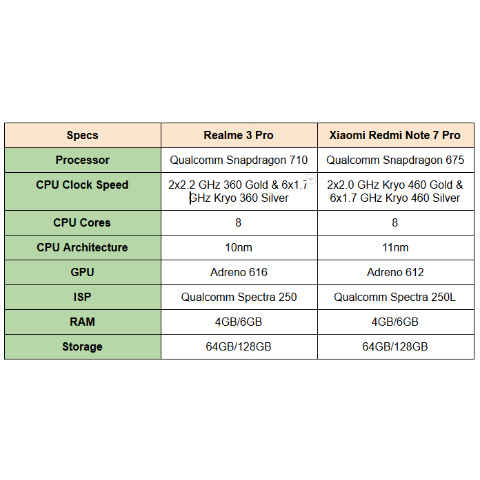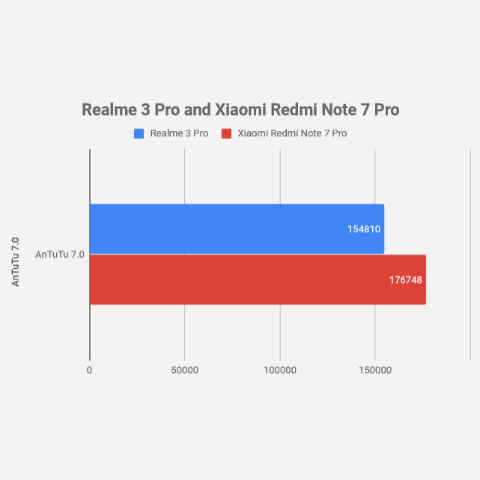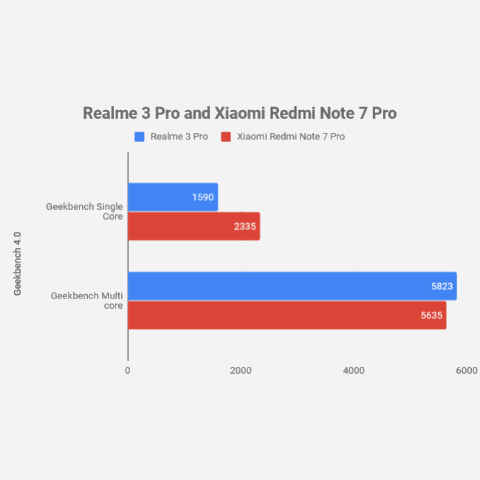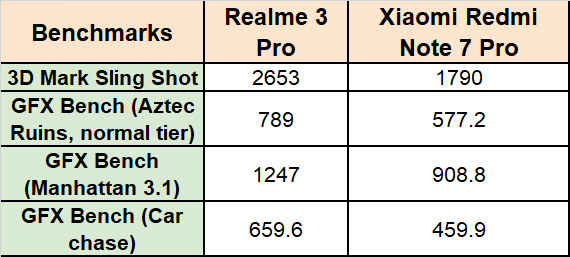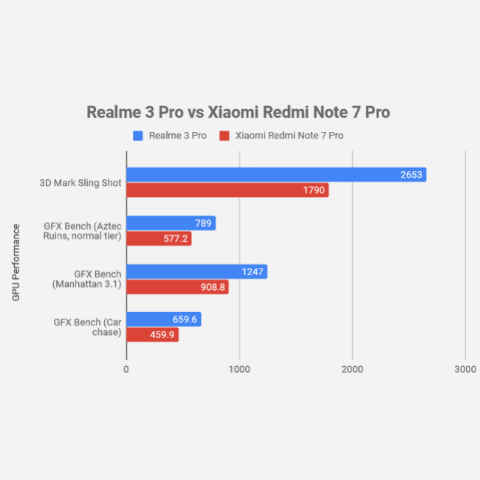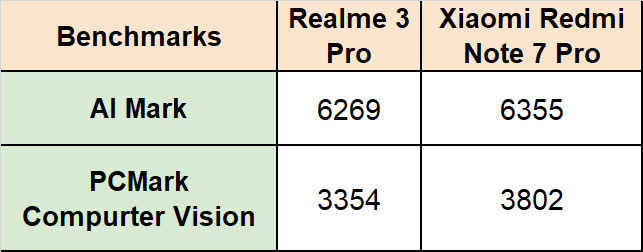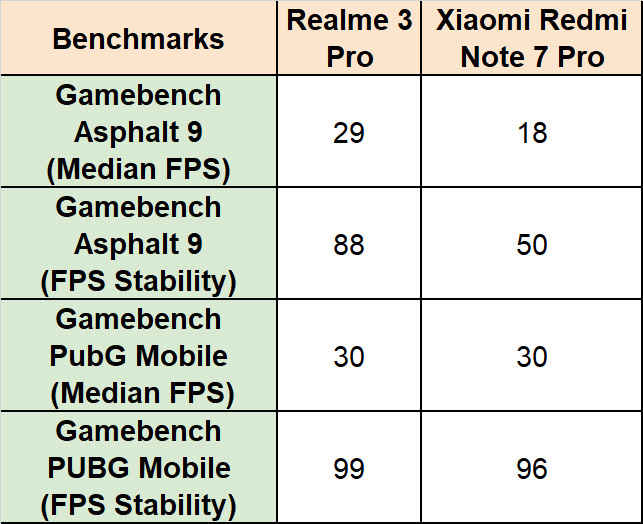Realme 3 Pro vs Xiaomi Redmi Note 7 Pro performance comparison: In search of the fastest mid-range smartphone
The Realme 3 Pro and the Xiaomi Redmi Note 7 Pro compete neck-to-neck, but which is the better mid-range smartphone to buy under Rs 15,000? We find out.

If you look at the mid-range smartphone market in India right now, there are two distinct smartphones that have taken each other head-on, each armed with their own specialities. We’re talking about the Xiaomi Redmi Note 7 Pro and the newly announced, Realme 3 Pro. Even before the phone’s launch, the two brands have been at loggerheads on social media, each trying to show the other as a lesser choice. Both have their reasons to show off, but at the end of the day, it’s the overall performance of the phone that determines the ultimate winner. We ran our suite of performance-tests on the Realme 3 Pro and the Xiaomi Redmi Note 7 Pro to find the fastest mid-range phone you can buy under Rs 15,000.
 Survey
SurveyRealme 3 Pro vs Xiaomi Redmi Note 7 Pro
Before diving in, let’s take a good hard look at the spec-sheet of the two phones to see where they draw their juice from. The Realme 3 Pro is powered by the Qualcomm Snapdragon 710, the first of the series that the San Diego-based chipset designer launched last year to bridge the gap between mid-range and flagship chipsets. It can be taken as an upper mid-range chipset of sorts.
The Xiaomi Redmi Note 7 Pro, on the other hand, relies on the Snapdragon 675, a chipset that Qualcomm tuned for smartphone gaming. Qualcomm tuned the platform to reduce frame drops in games, yet the specs of the processor are slightly lower than the Snapdragon 710, especially the clock-speed.
The major difference between the two’s compute structure is the fact that the Snapdragon 675’s performance cores are based on the latest ARM Cortex-A76 cores, same as the Snapdragon 855, while the Snapdragon 710’s Kryo 360 cores are based on ARM Cortex A75 cores. The GPU on the Snapdragon 710 is also slightly more advanced than the Snapdragon 675’s, although Qualcomm has revealed little about technicalities when it comes to their GPUs.
Based on the spec-sheet, there’s little to differentiate between the two phones, even though they are based on different platforms altogether. The RAM and storage variants are also the same, although Realme spreads the options out with another 6GB RAM and 64GB storage variant in between.
In this comparison, we used the 6GB/128GB variant of the Realme 3 Pro and the 4GB/64GB variant of the Xiaomi Redmi Note 7 Pro.
Which is the best performing smartphone in the mid-range segment? Let’s find out —
CPU Performance
Looking at CPU performance alone, the Redmi Note 7 Pro is ahead of the Realme 3 Pro in most of the tests we ran. AnTuTu rated the Redmi Note 7 Pro higher than the Realme 3 Pro and so did PCMark’s Work 2.0 and Mobile Xprt 2015.
AnTuTu rated the Redmi Note 7 Pro higher than the Realme 3 Pro and so did PCMark’s Work 2.0 and Mobile Xprt 2015.
In Geekbench however, the Realme 3 Pro was ahead in multi-core performance indicating that multi-tasking could be better on the new entrant.
The reason why the Redmi Note 7 Pro seemingly performs better on CPU benchmarks is because of the use of the latest Cortex A76 cores over the Cortex A75 on the Realme 3 Pro. This is despite the Snapdragon 710 peaking at a higher frequency than the Snapdragon 675. This is what makes comparing the two phones so interesting. Qualcomm essentially cannibalised a higher-range CPU with a mid-range one by using a newer CPU architecture.
GPU Performance
While the Redmi Note 7 Pro came out as the winner in CPU performance, the GPU section was dominated by the Realme 3 Pro.
The Adreno 616 proved to be faster in processing graphics and in 3DMark Slingshot, the phone scored 2653 while the Redmi Note 7 Pro scored 1790. Furthermore, in the GFXBench tests, the Realme 3 Pro was consistent in rendering more frames than the Redmi Note 7 Pro.
AI Performance
The Redmi Note 7 Pro seems to be faster in handling AI tasks like image recognition and other Computer Vision operations than the Realme 3 Pro. The two benchmark tests we ran pegged Xiaomi’s mid-ranger as the faster of the two. This is likely because the Snapdragon 675 has Qualcomm’s 3rd generation AI Engine while the Snapdragon 710 has used the previous generation. Both make use of the CPU, GPU and the DSP to compute AI tasks.
However, calculating AI performance is a tricky affair. It may be that the Redmi Note 7 Pro is faster on benchmarks, it’s what the phone does with the compute power that matters. In this case, both phones deploy the AI Engine to optimise gaming and in the camera app. Measuring them is problematic as they are purely experiential and quality may differ from one user to another.
Gaming Performance
So far, the Realme 3 Pro and the Redmi Note 7 Pro proved to be almost equally powerful, but in different aspects. To determine a winner, we played two high-intensity games — PUBG Mobile and Asphalt 9 and measured the gaming performance using GameBench. Both games were run in the highest possible quality supported in the devices.
PUBG Mobile
Both the Realme 3 Pro and the Redmi Note 7 Pro allowed gameplay in high graphics settings by default. On top of that, we also turned on anti-aliasing and disable auto-adjust graphics. At high settings, both phones offered a stable 30 FPS. However, the Realme 3 Pro’s performance was exceptionally good with 99 percent stability while the Redmi Note 7 Pro came close with 96 percent stability. In-game textures like grass, houses, and vehicles look more or less realistic although the Realme 3 Pro did show some amounts of screen tearing in indoor areas where light comes in through the windows. Otherwise, both phones handle the game perfectly well with little to no glitches.
Asphalt 9
In Asphalt 9, the two phones showed a marked difference in performance. The Realme 3 Pro was quite stable with 29 FPS at 88 percent stability while the Redmi Note 7 Pro offered 18FPS at 50 percent stability. Once again, we played the game at the highest graphics settings supported and the performance of Realme 3 Pro was equal to what we get on flagship phones. There was a noticeable difference in the quality of the two phones. It becomes clear that the Redmi Note 7 Pro handles PUBG Mobile better because it’s particularly optimised for the game, while the Realme 3 Pro simply relies on the superior GPU to deliver higher performance on both the games.
Daily Usage
In our suite of performance tests, the Realme 3 Pro and the Redmi Note 7 Pro performed neck-to-neck. Xiaomi’s mid-ranger is ahead in terms of daily usability thanks to a faster CPU while the Realme 3 Pro seems to handle gaming better. To conclude our test, we also observed how the two phones fared in terms of daily usage. I used the Realme 3 Pro for a week in a trip to Taipei while the Redmi Note 7 Pro has been with me since its launch. The Realme 3 Pro was also running on pre-production software and wasn’t completely optimised according to the company. But we did receive an update a few days before the launch and only then did we run the benchmark apps.
In terms of daily usage, both the Realme 3 Pro and the Redmi Note 7 Pro are far removed from the typical stock Android experience. Having said that, both MIUI 10 and now the ColorOS 6 have been refined to make them run smoothly and also look good. I wasn’t really a fan of Realme’s interface but the latest version made a lot of aesthetic changes that, along with system-level optimisations make the OS run quite smooth.
Also notably, we have to admit the Redmi Note 7 Pro unit which was shared by the brand with Digit.in for review during the launch did not show a single ad on the interface ever since I have been using it. However, we have noticed ads on the units bought in the flash sales. The Realme 3 Pro doesn’t show ads on the interface.
In Conclusion
The Realme 3 Pro serves as a good alternative to the Redmi Note 7 Pro and vice-versa if you are looking for a high-performing phone on a budget. Both phones are offered in flash sales, so it’s going to be equally difficult to buy either of them. Essentially, the Redmi Note 7 Pro is for someone looking for a stable daily performance while the Realme 3 Pro serves as a good smartphone for gaming.
